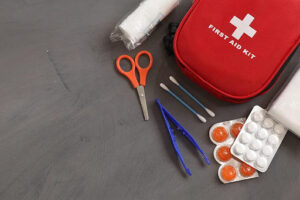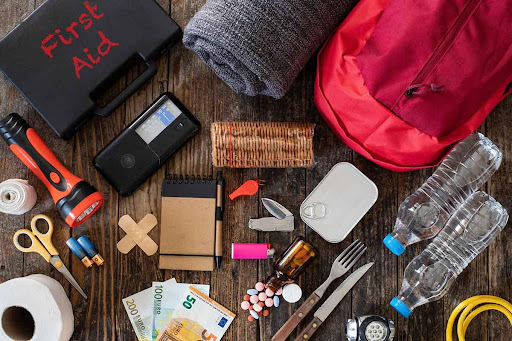Coastal North Carolina is renowned for its scenic beauty and vibrant culture, but it’s also no stranger to the havoc wreaked by tropical storms and hurricanes. Here, preparedness is not just a precaution, it’s a necessity. In this article, we’ll guide you through the process of assembling the ultimate storm kit – a lifeline when confronting the forces of nature.
From sustenance and communication to personal care and safety, we’ll delve into the essential items every Coastal North Carolina resident should have in their storm-ready arsenal. Let’s explore these crucial supplies to ensure you’re well-prepared for whatever storms come your way.
Essential Supplies for Your Storm Kit
 Image Source: Roger Brown on Pexels
Image Source: Roger Brown on Pexels
In the heart of storm country, having a well-equipped kit can make all the difference between resilience and vulnerability. Your supply kit should be stocked with a careful selection of essentials, each serving a unique role in ensuring your safety and well-being.
A. Food and Water Provisions: When the storm clouds gather, access to food and clean water can become scarce. In your kit, pack non-perishable food items like canned goods, energy bars, and dried fruits. Equally important is a supply of drinking water. Be sure to include enough for each family member for at least three days. To further bolster your water resources, consider adding water purification methods, such as water purification tablets or portable filters, to ensure access to safe drinking water in case supplies run low.
B. Emergency Lighting and Communication: Storms often bring power outages, leaving you in the dark. To combat this, equip your kit with flashlights and extra batteries. Additionally, having portable chargers for your electronic devices ensures you can stay connected and receive critical updates. Communication devices like two-way radios or a battery-operated NOAA weather radio are invaluable for receiving real-time information.
C. First Aid and Medical Supplies: Accidents can happen during storms, so a well-stocked first aid kit is paramount. Include essentials like bandages, antiseptic wipes, and over-the-counter medications for pain relief and fever reduction. For individuals with chronic conditions, it’s vital to keep a supply of prescription medications and copies of medical records in your kit.
D. Shelter and Warmth: When a storm disrupts your home, shelter and warmth become essential. Tents, tarps, or emergency blankets provide a safe haven, shielding you from the elements. Warm clothing, including layers, hats, and gloves, will help you retain heat. Don’t forget extra bedding like sleeping bags or blankets to ensure a comfortable rest during the tumultuous hours.
E. Tools and Equipment: Adapting and overcoming challenges is crucial during a storm. Multi-tools and utility items like wrenches, pliers, and duct tape are invaluable for makeshift repairs. For prolonged power outages, consider including a portable generator and an adequate supply of fuel to keep essential appliances running.
F. Personal Hygiene and Sanitation: Maintaining personal hygiene and sanitation is essential for comfort and health. Include items like soap, hand sanitizer, toothbrushes, and toilet paper. If possible, pack sanitation supplies like heavy-duty trash bags, waste disposal bags, and a portable toilet for proper waste disposal.
Each of these categories forms the backbone of your survival kit, offering the means to endure the storm and emerge from it unscathed. Assembling these essentials is a proactive step toward storm preparedness, ensuring you and your family are well-equipped to face the tempest.
Customizing Your Kit for Special Needs
 Image Source: Mat Napo on Unsplash
Image Source: Mat Napo on Unsplash
While a well-rounded kit is the foundation of preparedness, it’s equally important to customize it to meet the specific needs of your family and household members. Here are considerations for tailoring yours to accommodate those with special needs:
A. Kits for Families with Infants and Young Children: Families with infants and young children must account for the unique requirements of their little ones. In your emergency kit, include an ample supply of baby formula, food, and diapers.
Ensure you have bottles, pacifiers, and baby wipes. Additionally, having comforting items like stuffed animals or favorite blankets can help soothe young children during the stressful times of a storm. Don’t forget age-appropriate activities and toys to keep kids occupied.
B. Pet Preparedness: Supplies for Your Furry Family Members: Your pets are part of your family, so their needs should be addressed in your kit. Keep extra leashes, collars, and identification tags on hand alongside food and water for your pets.
Pet carriers or crates are essential for safe transport during evacuations. Also, include any necessary medications or special care items for your pets. Familiar items like pet toys and bedding can provide comfort during the upheaval of a storm.
C. Considerations for Individuals with Medical Conditions or Disabilities: Individuals with medical conditions or disabilities should take extra precautions when assembling their storm kits. If you or a family member relies on medical equipment that requires electricity, consider backup power options such as portable generators or battery-operated equipment.
Include a comprehensive supply of necessary medications, along with extra doses, in case you’re unable to obtain refills during the storm. Keep a list of emergency contacts, healthcare providers, and any specific care instructions in your kit.
If mobility is a concern, make sure to pack mobility aids, such as wheelchairs or walkers. Customize your storm kit based on the specific needs of those in your household to ensure their safety and comfort.
These tailored provisions ensure that everyone, regardless of age, ability, or species, can navigate the challenges of a storm with confidence and safety.
Staying Informed and Emergency Planning
 Image Source: rawpixel.com on Freepik
Image Source: rawpixel.com on Freepik
Staying informed in the event of an emergency and having a clear plan are essential elements of storm preparedness.
Receive real-time information through weather alerts, local news apps, and NOAA weather radios. Ensure your devices are charged and have backup power sources.
Create a family emergency plan that includes meeting places, communication methods, and assigned responsibilities for each family member. Discuss routes to evacuate and practice the plan regularly to ensure everyone knows what to do during a storm.
Know the evacuation routes and shelter locations in Coastal North Carolina. Familiarize yourself with the designated shelters and routes, understanding their capacities and pet-friendly policies. Being informed about these options ensures your readiness for storm-related scenarios, whether staying home or seeking shelter in designated locations.
Maintenance and Rotation of Supplies
Ensuring the longevity and reliability of your emergency supply kit is crucial for effective storm preparedness. Regularly checking and replenishing perishable items is the first step. Monitor and replace the perishables in your kit, such as food and medications, as they approach their expiration dates.
Inspect and test equipment like flashlights and batteries to ensure they’re in working order. Keep batteries fresh and functional, and periodically charge and test rechargeable devices or generators.
Lastly, stay up-to-date with the changing needs and circumstances of your family. As these change, update your storm kit accordingly. Consider the needs of new family members, adjust supply quantities, and make accommodations for individual requirements to keep your kit tailored to your family’s situation.
Additional Considerations for Storm Preparedness
 Image Source: Freepik
Image Source: Freepik
Beyond your kit, there are other essential factors to enhance your readiness for severe weather.
A. Home Fortification and Safety Measures: Reinforce your home by securing doors and windows, reinforcing the roof, and clearing your yard to minimize risks during a storm.
B. Insurance and Documentation: Ensure you have proper insurance coverage and safeguard important documents, such as insurance policies, identification, and medical records, in a waterproof container in your storm kit for easy access.
C. Community Resources and Support: Stay connected with local community resources, emergency shelters, and organizations. Volunteering and participating in community preparedness programs can provide valuable support and a sense of unity during storm events.
These considerations complement your storm kit, enhancing your safety and resilience in the face of severe weather.
Wrapping Up
In the face of Coastal North Carolina’s unpredictable and formidable storms, preparedness is not merely a choice; it’s a necessity. Assembling a comprehensive storm kit, customizing it to meet the unique needs of your family, staying informed, and accounting for additional considerations like home fortification and community support are all vital steps in ensuring your safety and resilience.
By embracing these measures, you not only protect your loved ones and property but also strengthen your ability to weather the tempests that may come your way. So, as you embark on your storm preparedness journey, remember that your commitment to readiness is an investment in your and your community’s well-being. Stay safe, stay prepared, and stay strong.



Leave a Reply